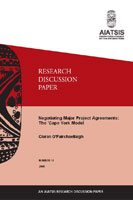Negotiating major project agreements: The Cape York model
This paper outlines a model for the negotiation of major project agreements developed in the 1990s by Cape York Aboriginal communities and the Cape York Land Council (CYLC), the Native Title Representative Body (NTRB) for Cape York. The fundamental objectives of the model are threefold:
- to place Aboriginal people in a position to make informed decisions relating to whether or not they wish to approve proposed developments or support existing mining operations (for instance, by consenting to the grant of additional mining leases)
- to put them in as strong a position as possible to maximise the financial and non-financial benefits they receive and minimise the costs they incur from any activities they support or projects they approve
- to create a process which places as much control as possible in the hands of the traditional owners and other community members who will be affected by mining activities.
The model also has major advantages for the developer. Its inclusive and transparent nature minimises the possibility of any later legal or political disputes relating to the activities or projects involved. As a result it diminishes uncertainty, a critical outcome in relation to activities and projects which usually require investments in the hundreds of millions of dollars and in which many sources of uncertainty (for instance fluctuating markets or changing technology) cannot be negotiated so decisively. In addition, the model can, by facilitating Indigenous input, allow projects to be designed in ways which allow negative impacts to be avoided or mitigated, reducing future remediation costs for the proponent.
